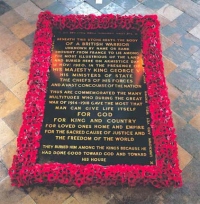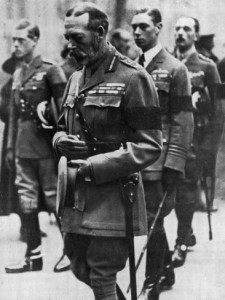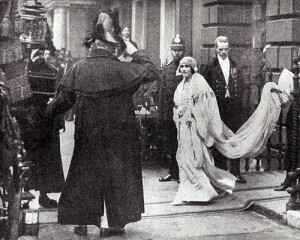
The Queen and the Duke of Edinburgh lead a procession of members of the royal family including Prince William and Prince Michael of Kent on November 11, 2012. Photo Credit: Getty Images
The royal family marked Remembrance Day in different parts of the world today. Queen Elizabeth II presided over the national ceremony in the United Kingdom at the cenotaph at Whitehall, laying a wreath in memory of British servicemen and women who gave their lives in wartime. Prince William, dressed in his Royal Air Force uniform also laid a wreath with the message, “For Jo, Lex and all those who have made the ultimate sacrifice for our country” referencing his friends from Sandhurst, Lt Joanna Dyer who died in Afghanistan in 2009 and Major Lex Roberts who died in Iraq in May 2007.
Other members of the royal family in attendance included the Duchess of Cambridge and the Countess of Wessex, who watched the ceremony from the Foreign Office balcony. In New Zealand, the Prince of Wales and Duchess of Cornwall attended a Remembrance Day ceremony in Auckland as part of their Diamond Jubilee tour of Australia, New Zealand and Papua New Guinea while the Queen’s cousin Prince Edward, Duke of Kent marked the occasion in the Falkland Islands as part of his Jubilee visit. Remembrance Day is particularly significant for the entire royal family this year as Prince Harry is on active duty in Afghanistan and will remain there through the Christmas holiday.
On November 11, 1920, Queen Elizabeth II’s grandfather, King George V marked the most significant Remembrance Day in British history, laying to rest the Unknown Warrior in his tomb in Westminster Abbey. The funeral procession for the unidentified serviceman, who represented all the dead from Great Britain and the British Empire during the First World War, began at Whitehall. There, King George V unveiled the cenotaph where all subsequent national Remembrance Day ceremonies have taken place and laid a wreath on the coffin. The King and three of his surviving sons, the future Edward VIII, the future George VI and the Duke of Gloucester walked behind the gun carriage carrying the coffin as it slowly traveled to the North entrance of Westminster Abbey.
In the Abbey, female members of the royal family including the King’s mother, Queen Alexandra, his sister, Queen Maud of Norway and his cousin, Queen Victoria Eugenia of Spain led a congregation of women who had lost husbands and sons during the First World War. The congregation watched as the King scattered a handful of French earth on the coffin before it was lowered into the grave. The Unknown Warrior’s Coffin was covered with the contents of one hundred sandbags of French earth and a simple black stone with a long inscription that concluded, “THEY BURIED HIM AMONG THE KINGS BECAUSE HE
HAD DONE GOOD TOWARD GOD AND TOWARD HIS HOUSE.” The placement of the tomb in Westminster Abbey where so many British monarchs were buried symbolized the nation’s gratitude to the men and women who served in the First World War.
In 1923, the tomb of the Unknown Warrior became the site of a new royal wedding tradition when Lady Elizabeth Bowes-Lyon, the future Queen Elizabeth, the Queen Mother laid her bridal bouquet on the memorial as she entered Westminster Abbey to marry Prince Albert, Duke of York, the future King George VI. This act honoured her elder brother, Captain Fergus Bowes-Lyon who died in the Battle of Loos and was buried in an unknown grave. Since 1923, subsequent royal brides have left their bouquets on the tomb of the Unknown Warrior the day after their weddings.
The Queen’s current Remembrance Day traditions follow the example set by her grandfather, King George V. The King reigned through the First World War and led his nation in mourning for the losses suffered during the hostilities. The Tomb of the Unknown Warrior was dedicated by the King to commemorate all those died serving their country and the tomb acted as a focal point for national mourning in the decades following the burial.



Carolyn,
You mentioned three of King George V surviving sons. Where was the fourth surviving son, H.R.H. Prince George, the future Duke of Kent — the father of the future H.R.H. Prince Edward, Duke of Kent, H.R.H. Princess Alexandra, the Honourable Lady Ogilvy, and H.R.H. Prince Michael of Kent — on that Remembrance Day in 1920? What irks me is the fact that Prince George, Duke of Kent was killed in 1942 — a mere six weeks after his younger son’s birth — is continuously overlooked whenever people discuss the current Royal Family today.
Keep up the good work.
GOD SAVE THE QUEEN
Ronald A. McCallum
I apologize for the typo – the article should read “three of George V’s surviving sons.” Accounts of the burial service all state that only three of the princes, the future Edward VIII, the future George VI and Henry, Duke of Gloucester, were present. I am not sure where the Duke of Kent was at the time of the ceremony.
Mystery solved! According to royal expert Marlene Koenig, the Duke of Kent was at sea as a cadet on the battleship Temeraire.